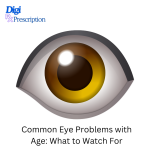
As we age, our eyes undergo natural changes that can affect vision and eye health. Some of these changes are mild and manageable, while others can lead to significant vision loss if left untreated. In this blog post, we’ll explore common age-related eye problems, their symptoms, and how to manage them to maintain healthy vision for years to come.
1. Presbyopia (Age-Related Farsightedness)
Cause: The eye’s lens loses flexibility, making it harder to focus on nearby objects.
Symptoms:
-
Difficulty reading small print
-
Holding books or phones at arm’s length to see clearly
-
Eye strain or headaches
Management: -
Reading glasses or bifocals
-
Prescription lenses for close-up work
2. Cataracts
Cause: Clouding of the eye’s natural lens, typically due to protein buildup over time.
Symptoms:
-
Blurry or foggy vision
-
Sensitivity to bright lights
-
Colors appearing faded
-
Difficulty seeing at night
Management: -
Wearing anti-glare sunglasses
-
Improved lighting at home
-
Cataract surgery when vision is significantly impaired
3. Glaucoma
Cause: Increased pressure inside the eye damages the optic nerve, leading to vision loss.
Symptoms (often subtle at first):
-
Loss of peripheral (side) vision
-
Tunnel vision in advanced stages
-
Eye pain or redness (in some types of glaucoma)
Management: -
Regular eye exams to monitor pressure
-
Prescription eye drops to reduce intraocular pressure
-
Surgery or laser treatments in severe cases
4. Age-Related Macular Degeneration (AMD)
Symptoms:
-
Blurred or distorted central vision
-
Difficulty recognizing faces
-
Straight lines appearing wavy
Management: -
Eating a diet rich in leafy greens and omega-3 fatty acids
-
Taking AREDS (Age-Related Eye Disease Study) supplements
-
Anti-VEGF injections for wet AMD
5. Dry Eye Syndrome
Cause: Reduced tear production or poor tear quality due to aging.
Symptoms:
-
Gritty or burning sensation in the eyes
-
Redness and irritation
-
Sensitivity to wind and smoke
Management: -
Using artificial tears or lubricating eye drops
-
Staying hydrated and avoiding excessive screen time
-
6. Diabetic Retinopathy
Cause: High blood sugar damages blood vessels in the retina, leading to vision problems.
Symptoms:
-
Blurry or fluctuating vision
-
Dark spots or floaters
-
Vision loss in severe cases
Management: -
Controlling blood sugar levels
-
Regular eye exams for early detection
-
Laser therapy or injections for advanced cases
7. Retinal Detachment
Cause: The retina pulls away from the back of the eye, often due to aging or injury.
Symptoms:
-
Sudden flashes of light
-
A curtain-like shadow over part of the vision
-
Increase in floaters (tiny specks or strings in vision)
Management: -
Immediate medical attention is required
-
Surgery may be needed to reattach the retina
Tips to Maintain Eye Health as You Age
✔ Get Regular Eye Exams: Early detection can prevent vision loss.
✔ Eat an Eye-Healthy Diet: Include leafy greens, fish, and nuts rich in omega-3s.
✔ Wear Sunglasses: Protect your eyes from harmful UV rays.
✔ Quit Smoking: Smoking increases the risk of cataracts and AMD.
✔ Take Breaks from Screens: Follow the 20-20-20 rule—every 20 minutes, look at something 20 feet away for 20 seconds.
References:
-
American Academy of Ophthalmology – https://www.aao.org
-
National Eye Institute – Aging and Vision Loss – https://www.nei.nih.gov
-
Mayo Clinic – Cataracts and Glaucoma – https://www.mayoclinic.org
-
Harvard Medical School – Eye Health Tips – https://www.health.harvard.edu
